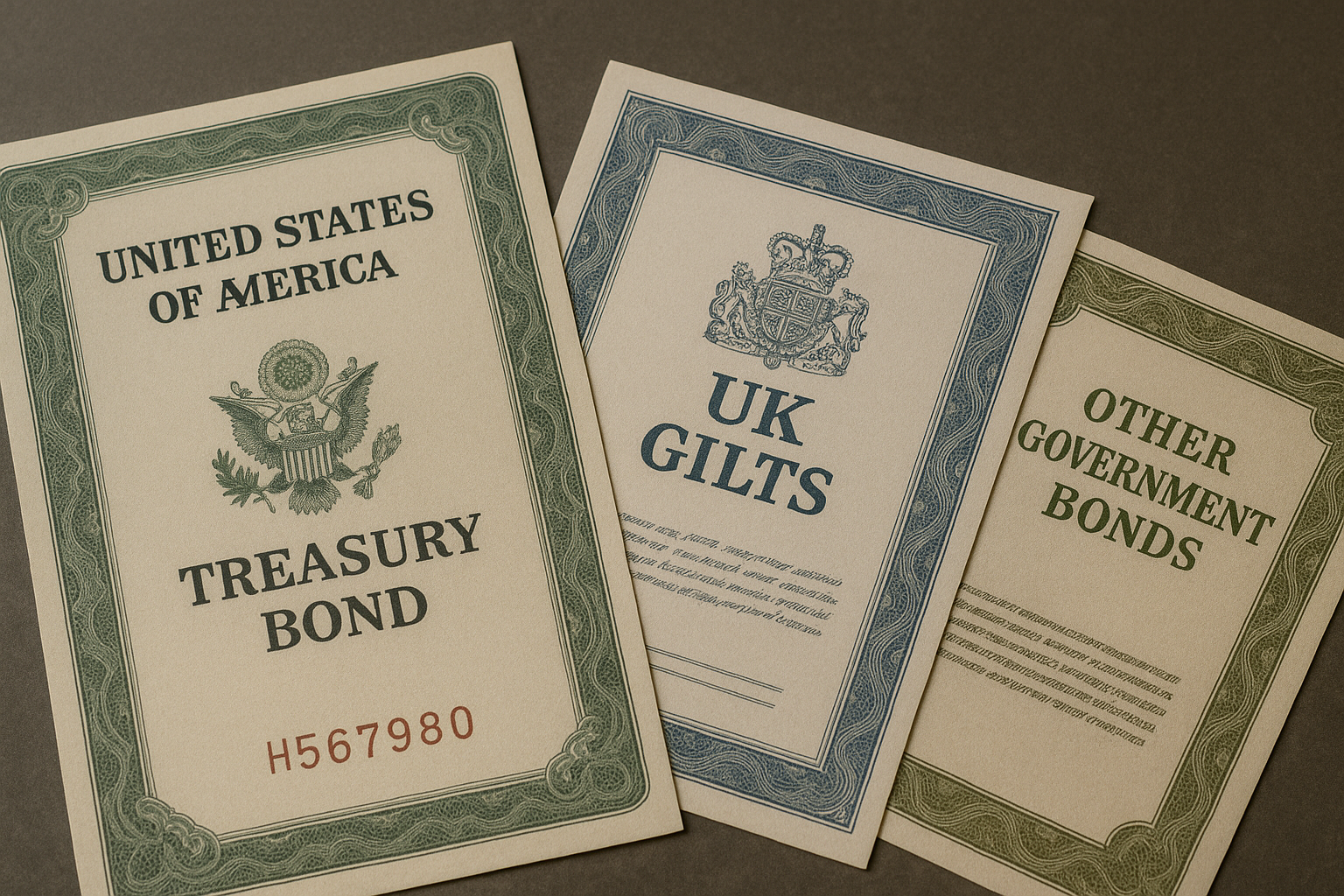Gold vs Government Bonds: Which is the Better Investment?
14/08/2025Daniel Fisher
Free & fully insured UK Delivery. Learn more
Secure & flexible payments. Learn more

Buyback Guarantee Learn more

In today’s unpredictable economy, many investors are looking for ways to protect their wealth and reduce risk. Two of the most popular options are gold and government bonds. Both are considered safer than shares, yet they work in very different ways and react differently to market conditions.
Gold is known as a store of value and a hedge against inflation or currency weakness. It often performs well during periods of uncertainty. Government bonds, such as U.S. Treasury bonds and UK gilts, are designed to provide steady, predictable income and are backed by national governments, making them some of the lowest-risk investments available.
However, not all government bonds are equally safe or priced the same way. Bonds from highly rated countries tend to be stable, while those issued by less financially secure governments may carry higher yields but also more risk.
Choosing between gold and government bonds often comes down to whether you prioritise protection against inflation and market shocks or reliable income and capital stability.
Government bonds are debt securities issued by a country’s government to fund public spending. When you buy one, you’re essentially lending money to the government in exchange for regular interest payments and the return of your principal when the bond matures.
While the term “government bond” is broad, two of the most widely traded are U.S. Treasury bonds (T-bonds) and UK gilts. They are both issued by highly rated governments and carry extremely low default risk. Other examples include German Bunds, Japanese Government Bonds (JGBs), and Australian Government Bonds. Bonds from emerging market countries, such as Brazil or Turkey, can offer higher interest rates but may carry greater credit risk and price volatility.
Over the past decade or so, even the most highly regarded government bonds have faced challenges. Rising national debt levels have caused once unshakable issuers to lose their coveted ‘Triple AAA’ credit ratings. The US was downgraded by Standard & Poor’s in 2011, and the UK saw its first downgrade in 2013. These changes not only increased borrowing costs for the governments involved but also altered the risk profile for investors who once viewed such bonds as virtually risk-free.
Government bonds are sold with set maturity dates that can range from months to decades. Treasury bonds typically have terms of 20 or 30 years, while UK gilts can have maturities from just a few months to more than 50 years. When you invest, you receive a fixed interest payment (coupon) until maturity, at which point you get back the full face value of the bond.
The main source of income from government bonds is the coupon payment. You can also sell your bond before maturity in the secondary market. If interest rates have fallen since you bought the bond, its market value will likely rise, allowing you to sell at a profit. If interest rates have risen, the opposite is true, and the bond’s price may fall.

The main difference is their maturity length and how they pay interest:
Government bonds remain one of the most trusted investments for those seeking stability and predictable returns. Issued by national governments to raise funds, they are generally backed by the “full faith and credit” of the issuing country, making them among the lowest-risk assets available.
Key reasons investors choose government bonds include:
While yields can be modest, the stability and income they provide can be a crucial counterbalance to more volatile investments like equities or commodities.
Government bonds have played a steady, if unspectacular, role in building and protecting wealth for centuries. Their performance is shaped largely by interest rate trends, inflation, and credit quality.
Although government bonds may not match the long-term growth potential of equities or the crisis-era surges of gold, their track record of income, liquidity, and low default risk ensures they remain a cornerstone in many diversified portfolios.
Free ultimate guide for keen precious metals investor
Gold has been valued for centuries as a store of wealth. Today, it remains a popular hedge against inflation, currency devaluation, and financial instability. Unlike bonds, gold does not produce income. Instead, its return comes entirely from price appreciation.

Read our detailed comparison of Physical Gold and Gold ETFs
Gold has been valued for thousands of years, not just as jewellery or currency, but as a way to protect and grow wealth. Modern investors often see gold as more than just a commodity, it’s a financial safety net.
Key reasons investors choose gold include:
While gold doesn’t pay interest or dividends, its potential for price appreciation and its defensive qualities make it a staple in many long-term investment strategies.
Insider tips to help you profit from gold investing
Gold’s track record shows why it is often called a store of value. Over the past 50 years, it has weathered recessions, inflation spikes, and market crashes, often outperforming other assets in times of crisis.
However, gold’s performance is not always positive. During periods of stable economic growth and rising interest rates, gold can underperform assets that generate income, such as bonds or equities. This makes timing and diversification key to getting the most from gold in a portfolio.
Gold prices can swing sharply in response to market sentiment, interest rate changes, and currency movements. Treasury bonds and Gilts, in contrast, have minimal default risk because they are backed by the U.S. and UK governments respectively, though they are still sensitive to interest rate changes.
Gold ETFs are highly liquid, allowing fast transactions. While it’s easy to sell well-known bullion coins and bars in a day, selling collectible gold coins or obscure gold can take more time.
Treasury bonds are also liquid, and although selling before maturity can lead to price fluctuations, the secondary market is deep and active.
Gold’s returns come entirely from price changes, which can be significant during inflationary or crisis periods. Treasury bonds offer fixed interest payments that make them reliable but less likely to outpace inflation without TIPS.
Gold has historically been a strong hedge during inflation, maintaining purchasing power. Treasury bonds generally lose real value when inflation is high unless they are inflation-protected securities.
In the UK, the tax treatment for gold and government bonds depends on the type of investment and how it is held.
Gold: Physical investment-grade gold coins and bars that meet required purity standards are exempt from VAT.
Certain UK gold coins, such as Britannias and Sovereigns, are also exempt from Capital Gains Tax (CGT) because they are considered legal tender.
Other forms of gold, including gold exchange-traded funds (ETFs) and gold mining shares, may be subject to CGT on any profits when sold.
Government Bonds: Interest from UK gilts is subject to Income Tax at your marginal rate unless the bonds are held within a tax-efficient wrapper such as an ISA or SIPP, in which case interest and gains can be tax-free.
Most gilts are exempt from CGT, so any gain from selling them is usually tax-free. The same principles apply to most other highly rated government bonds purchased by UK investors, although overseas bonds may be subject to different tax rules, including potential currency gains or losses, which can be taxable.
Our automated portfolio creator will help you choose the ideal selection based on your budget and objectives.
Gold is often the better option when the priority is preserving purchasing power and safeguarding against uncertainty rather than generating income. Real-world scenarios where gold has shone include:
While gold can be a strong defensive asset, it may be less suitable for investors needing regular, predictable income or those looking for short-term stability in portfolio value.
Government bonds can be the better choice when the focus is on capital stability and generating steady, reliable income. Situations where they tend to outperform include:
While bonds can offer stability and income, their value can fall if interest rates rise sharply or if inflation erodes their real returns.
For many investors, the best solution is not choosing one over the other but holding both. Gold can provide protection against inflation and market shocks, while government bonds can deliver reliable income and capital stability. A blended approach can help smooth returns across different market conditions, balancing safety with long-term growth potential.
There’s no one-size-fits-all answer to whether gold or government bonds are the better investment, it depends entirely on your financial goals, risk tolerance, and time horizon.
The natural fluidity and evolution of financial markets requires portfolios to be equally flexible to keep up. That may mean tweaking the amount of gold and Gilts you have at various parts of the economic cycle, while also being ready to switch up allocations if personal circumstances change.
If you want protection against inflation, currency weakness, or geopolitical uncertainty, gold has historically been a strong store of value. It performs well during crises and can add valuable diversification to a portfolio.
If you prioritise predictable income, capital stability, and low default risk, government bonds – whether UK gilts, U.S. Treasuries, or other highly rated sovereign debt – are hard to beat. They can deliver steady returns and offer certain tax advantages for UK investors, particularly when held in ISAs or SIPPs.
For many investors, the most effective strategy is not choosing one over the other but holding both. Gold can act as a hedge when markets turn volatile, while bonds can provide stability and income in calmer periods. This balance can help smooth returns and protect wealth across different market conditions.


It depends on your goals. Gold is better for protecting against inflation, currency weakness, and geopolitical risk, while U.S. Treasuries offer predictable income and low default risk. Many investors hold both for diversification.
Gold can hedge against inflation, protect wealth during crises, and has no default risk. It is also globally liquid and can rise in value when interest rates fall or currencies weaken. Treasuries, by contrast, pay interest but can lose value if rates rise.
Gold and Treasuries generally have a low or negative correlation. In times of market stress, both can rise as safe-haven assets, but when interest rates increase, Treasuries may fall while gold’s performance depends more on inflation and investor sentiment.
Rising bond yields can put downward pressure on gold prices because higher yields increase the opportunity cost of holding a non-interest-paying asset. However, if yields are rising due to inflation fears, gold may still hold or gain value.
Yes. Holding both gold and Treasuries can balance a portfolio. Gold offers protection against inflation and market crises, while Treasuries provide steady income and stability. Together, they can reduce overall risk and improve long-term resilience.
Not necessarily. Gold is more volatile but can protect against inflation, while Treasury bonds are stable and government-backed.
It depends on the economy. Gold often outperforms during high inflation, while bonds do better in stable, low-inflation periods.
Not directly, except for TIPS (Treasury Inflation-Protected Securities). Regular Treasury bonds can lose value in high inflation.
Yes. Gold prices fluctuate daily and can drop if interest rates rise or economic confidence improves.
Live Gold Spot Price in Sterling. Gold is one of the densest of all metals. It is a good conductor of heat and electricity. It is also soft and the most malleable and ductile of the elements; an ounce (31.1 grams; gold is weighed in troy ounces) can be beaten out to 187 square feet (about 17 square metres) in extremely thin sheets called gold leaf.
Live Silver Spot Price in Sterling. Silver (Ag), chemical element, a white lustrous metal valued for its decorative beauty and electrical conductivity. Silver is located in Group 11 (Ib) and Period 5 of the periodic table, between copper (Period 4) and gold (Period 6), and its physical and chemical properties are intermediate between those two metals.